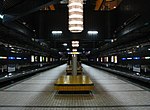Harcourt House, Edmonton

Harcourt House Artist Run Centre is one of four artist-run centres in Edmonton, Alberta, Canada. The centre delivers a host of services to both artists and the community, and acts as an alternative site for the presentation, distribution and promotion of contemporary art. Harcourt House Artist Run Centre is an artist-run, charitable organization that promotes contemporary visual art to interested individuals and organizations by providing education, exhibitions and resources. The Centre includes two public gallery spaces; and as the single largest community of visual artists in Edmonton, it offers 42 low-rent studios for local practicing artists and other non-profit arts related organizations. A unique area of programming to Harcourt House is the Art Enrichment program that serves over 25 local low income and special needs organizations with low/no cost art education classes.
Excerpt from the Wikipedia article Harcourt House, Edmonton (License: CC BY-SA 3.0, Authors, Images).Harcourt House, Edmonton
102 Avenue NW, Edmonton Central Core
Geographical coordinates (GPS) Address Nearby Places Show on map
Geographical coordinates (GPS)
| Latitude | Longitude |
|---|---|
| N 53.543055555556 ° | E -113.51333333333 ° |
Address
102 Avenue NW 11110
T5K 1T6 Edmonton, Central Core
Alberta, Canada
Open on Google Maps






